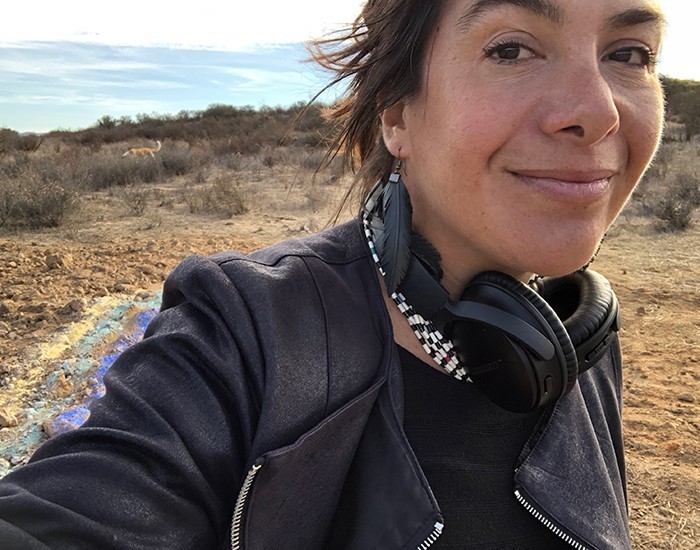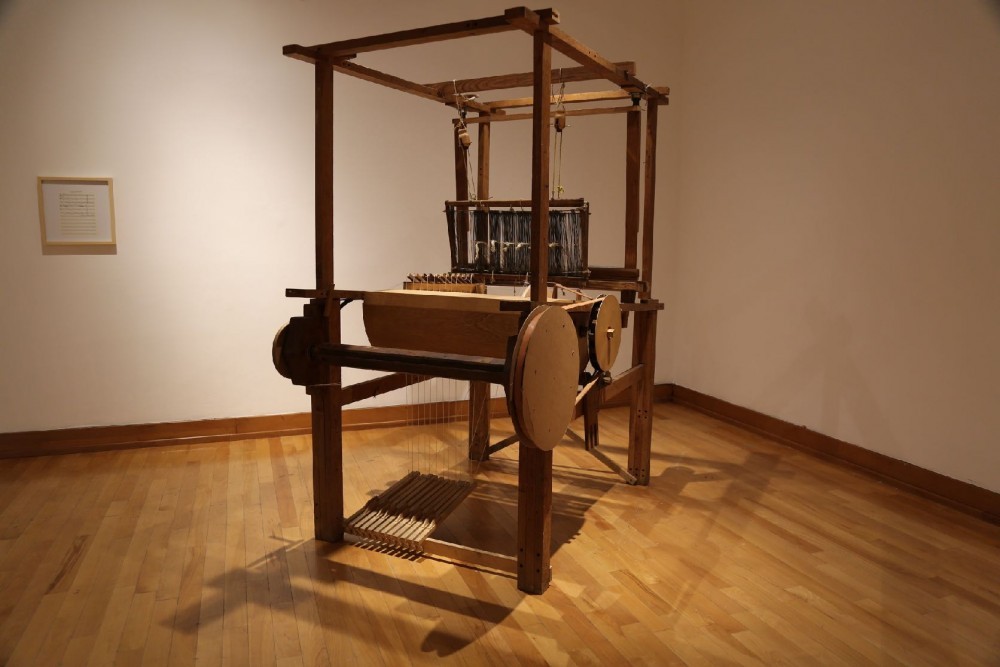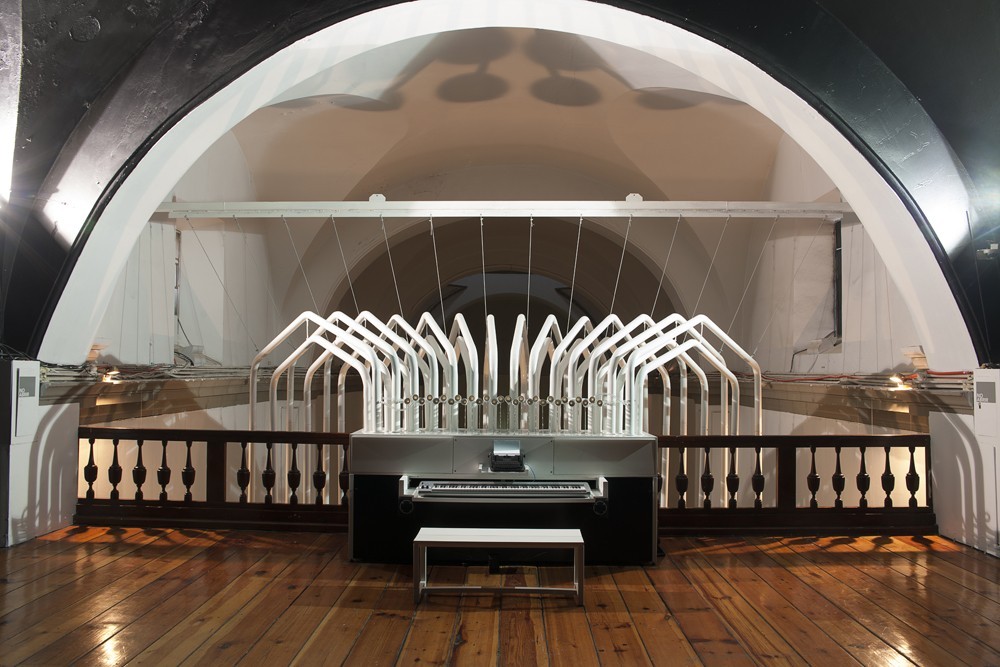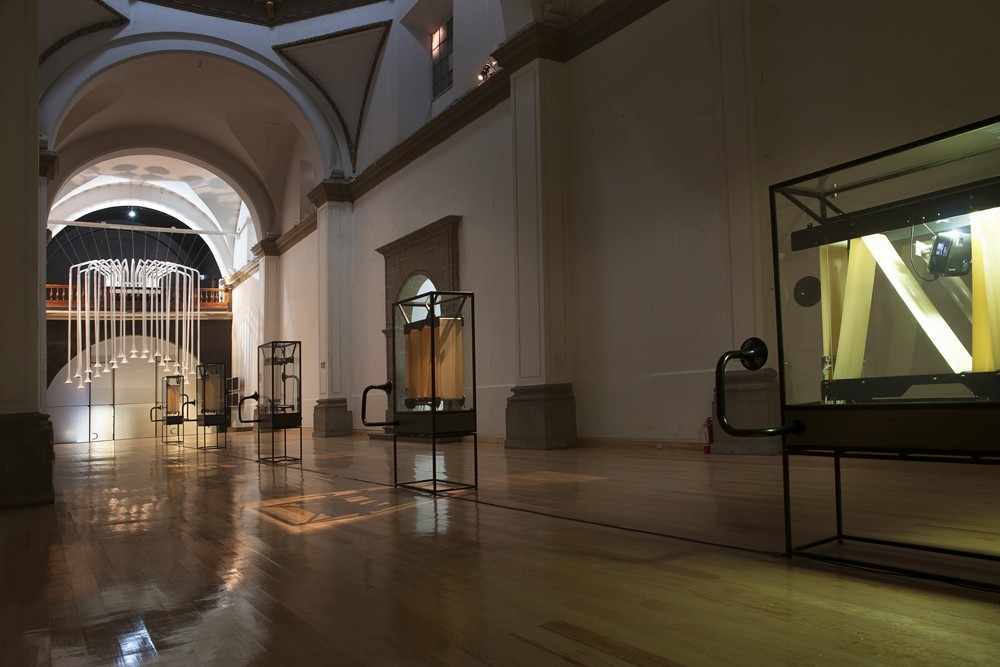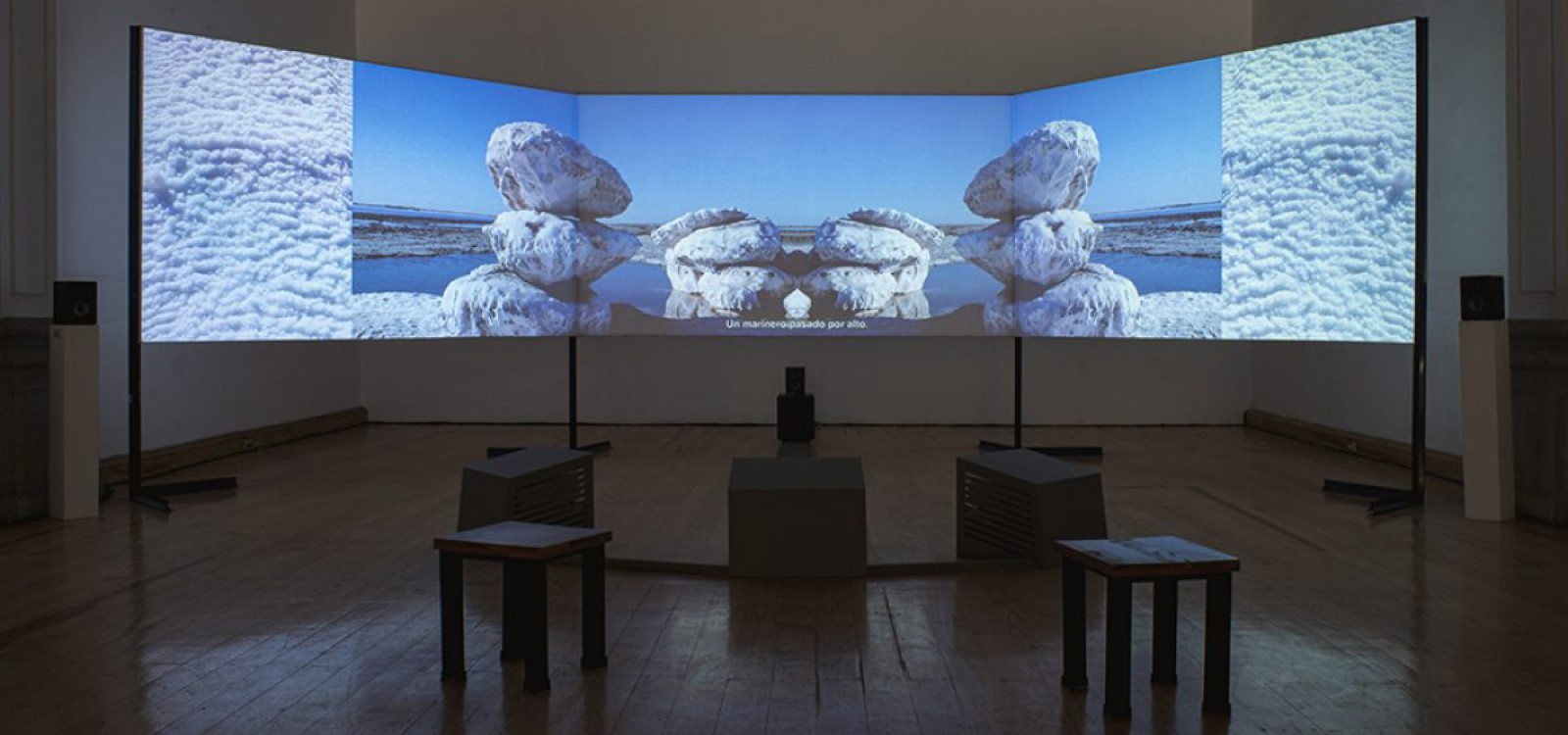
Tania Candiani: 'I am intrigued about how science's vision carries ideas of collective futures'
Tania Candiani is a Mexican artist, recipient of an Honorary Mention of the Collide Award. In this interview, she reflects on her interest in early technologies and the production of knowledge, the role of storytelling in her practice, and her Collide proposal Quantum Fictions, which seeks to draw connections between Indigenous Knowledge and Western Science.
In your proposal Quantum Fictions, you aim “to interweave connections between Indigenous Knowledge (considering the wide diversity of tribals) and Western Science”. Where do both ways of thinking overlap?
Indigenous perspectives are holistic and founded upon interconnectedness, reciprocity and the utmost respect for nature. Throughout history, Indigenous peoples have been responsible for the development of many technologies and have substantially contributed to science. A huge amount of knowledge has, however, been lost. The rejection of magical thinking and natural wisdom has done a lot of damage. Although the value of integrating Indigenous science with Western science has been recognized, we have only begun to scratch the surface of its wonders.
As ways of knowing, Western and Indigenous Knowledge share several important and fundamental attributes, both are constantly verified through repetition and verification, inference and prediction, empirical observations and recognition of pattern events. Science is the pursuit of knowledge. Approaches to gathering that knowledge are culturally relative. Indigenous science incorporates traditional knowledge and Indigenous perspectives, while non-Indigenous scientific approaches are commonly recognized as Western science. Together, they contribute substantially to modern science.
In search of answers to fundamental questions about the more-than-human history of the cosmos, particle physics has scrutinized the world at the quantum scale, altering what we know and revealing the extent of our unknowing. At the scale of particles, matter and energy behave very differently from the everyday reality that we see. The quantum world has its own materiality. At the same time, much Indigenous knowledge has had for hundreds of years an explanation of those fundamental questions, between the real and imaginary, the measurable and immeasurable, the visible and invisible, all simultaneously. The quantum entanglement, or the non-locality – considered the quintessential quantum effect – is “knowledge”, which has always been integrated into the cosmic vision of Aboriginal peoples, though not easily accepted by Western cultures.
I seek to merge two very different traditions – a Western aesthetic canon that privileges vision and metaphysical knowledge and Indigenous oral traditions in which knowledge and history are encoded in the body and ritual.
In my work, I like to think in terms of weaving. I am interested in weaving a new architecture of connectivity that enables the emergence of new realities. In this syncretic process, I seek to merge two very different traditions – a Western aesthetic canon that privileges vision and metaphysical knowledge and Indigenous oral traditions in which knowledge and history are encoded in the body and ritual.
What attracts you to CERN's scientific environment?
A cross-disciplines empathy through the enrichment of perception and cognition derived from the lived experience to physically perceive how scientists and artists acquire, process, and respond to information from their environment. Tensing the borders of cultures, deep time, ecosystemic relations in a complex interplay of fragility and the extraordinary.
The association between instruments and language took a new turn with the introduction of recording tools, which wrote their results in their own “languages.” These new languages are, in a way, “experimental graphics”. I am interested in finding new uses for these “graphic traces” and converting the narrative of the scientists into storytelling and metaphors.
Are philosophical instruments more like words, like things or are they somewhere in between? Establish that symbolic character of instruments, proposing alternatives to language and signs. The signal registered brings us back to the question of the natural magician. What does the instrument tell us? Does its voice reveal some secret of nature? In natural magic, words and things are closely linked: words are more than arbitrary symbols for something, they also contain an occult meaning, and one can learn about the thing through the word.
I would like to write/record/produce a visual essay operating through allegory and analogy, with hidden connections. Both the words and the instruments at CERN point to the hidden essences of things. They are a grammatical instrument that convokes.
What do you expect from your participation in the Guest Artists programme and your exchanges with the scientific community?
I expect to experiment with paradigms and systems of translating from the dimension of the invisible or inaudible. The existence of an expressive matter has deeply symbolic meanings and depth—eloquent, emotional, charged particles. Perception and faith are intertwined in a dialectic of presence and absence so that sense arises in the perceptual field rather than in subjectivity. So, I will be looking for having conversations from the perceptual imaginary where the possibility of interpretation can wonder us.
Your practice brings an understanding of borders from many different fields of knowledge and takes several outputs from films, installations to sound and writing. Could you tell us about your creative process?
I start from curiosity, finding things that amaze me and weaving concepts together. There is a fundamental part of empirical research with no order or rigour. Then, my creative process is marked by an oscillation of thought between materiality and abstraction. In its development, the ideas move like a pendulum between their mental and physical forms. All artefacts are vessels of meaning existing on a scale that extends from the most abstract to the most concrete.
The outcome of that research materialises in many ways and mostly in a group of works. It is important that the material has a conceptual or narrative relationship with the theme itself. I like when I’m able to find the way the material speaks by its own process.
I believe I learned this freedom of work between disciplines in the city where I “made myself”, Tijuana (Mexico), which is a border town. Borders are places of constant exchange, of evident, visible interaction. As if combing a pair of hair into a braid. And that is because, in reality, it is the same geography interrupted by a geopolitical imposition. That line is not imaginary, but it is a forceful accumulation of materials and politics translated into a series of gestures to continue being the same territory.
Also, I like to work on in-site specific projects. I dig into the history and identity of a building, a town, or a culture. I then focus on looking for connections and intersections between different identities, cultures, publics, platforms, disciplines, institutions, and ways of interpreting and living in the world.
My creative process is marked by an oscillation of thought between materiality and abstraction. In its development, the ideas move like a pendulum between their mental and physical forms.
How would you describe the relationship between your artistic practice and the “moment of invention” in the history of science and technology?
My interest in technology has to do with wonder, like in those times when technology was understood as a magical phenomenon. It has always been linked to the natural. It has evolved to explain ourselves and our world. I am fascinated by exploring the moment of invention, understanding it as one episode of an extraordinary story, which has been evolving in languages, approaches, philosophical intentions and meanings. I am also intrigued by how visions of scientific and technological progress carry with them implicit ideas about collective futures, public expectations, and the common good. These ideas are in constant evolution, not just in technological processes but in conceptual meanings.
Many exceptional innovations have not been fully developed, existing only in instructions, drawings, absurd contraptions, unfeasible gadgets, poetic constructions of utopian dreams, censored designs, and so on. I am particularly moved by these rescue (in the sense of finding) and forgotten inventions because of their absurdity, impracticality, or lack of relevance in the particular historical moment they were envisioned. Many of these technologies reveal past concepts of the future that never came to be. The negotiation between the past and the future acceding to the present moment becomes a form of cultural archaeology.
A concrete antecedent could be the Zanfona-Telar, 2015 (Hurdy-Gurdy in Loom). In this piece, a mechanical loom, a musical instrument from the XIV century and violin making techniques were integrated into an interactive artwork. Another example is Wooden Trumpets, 2014. The relationships between materials, trades, industry, crafts, functionality, and technology are woven together, connecting acoustic technologies of the XVII century, the mystics of alchemy, pre and post War radars, ear trumpets, distillation stills, do-it-yourself patterns, pre-industrial tools, and bagpipes. The result was a group of drawings, photographs, cut-outs, scale models and projections, and a series of wooden trumpets. I built them in collaboration with a Scottish master cabinetmaker, and each resulted in different shapes and, therefore, acoustics.
Combinations make the invention possible. It is an abundant resource for intertwining and adapting technical inventions, history of knowledge, the act of making, the process as an empirical observation, with methods, tools and modes of work taken from craftsmanship and traditional skills and knowledge. I am interested in applying this archaeology of knowledge to developing a body of work where the intersections of materials and disciplines speak to us about possible connections.
In your works Cónica, 2016 and Five Variations of Phonic Circumstances and a Pause, 2012, you have previously explored the multiple layers of scientific knowledge. How do you envision the creation of knowledge in scientific environments?
I believe it is great you mentioned these two projects. Cónica is based on the cosmogony and knowledge of the Kogi Indigenous People, from Tairona, Colombia; and Cinco Variaciones, an exploration and translation of technological citations inspired by Athanasius Kircher, the most extraordinary polymath from European knowledge.
My relation with knowledge and science happens from a non-objective approach—a bridge through the subjectivity where the notion of wonder magnifies its perspective. Specifically, with science, I have an ontological understanding of the primordial questions, a metaphysical form of extending my mental space and consciousness, exercising empirical observation based on a polysynthetic metaphysics of nature. This empirical approach turned out to be a condition for my creativity, based on joy, pleasure and phenomenological knowledge—an experimental exercise of chance and intuition.
My work has involved instruments from the natural magic tradition to technological imaginaries, which enchant us or substitute one sense for another (synesthesia). I took heads and trumpets, magic mirrors, automata and Aeolian harps, all invented by Athanasius Kircher when the distinction between science, magic, and belief had not yet been established, and it was thought that the movement of the stars was governed by divine laws. Kircher has been a constant reference in my work, ever since 2012’s Five Variations of Phonic Circumstances and a Pause, when, in long conversations with Karla Jasso—the curator of that exhibition at Laboratorio Arte Alameda—I came to understand him as one of the cornerstones of the archaeology of the media.
Instruments from the natural magic tradition continued to be invented through the 19th century, although they stopped being called magical. Natural magic never really disappeared but was instead subsumed into new categories, such as entertainment and natural science. We tend not to think of magic as a practical art—certainly not in a useful sense—but many of its objectives, such as creating realistic images without substance, communicating instantaneously across the world, imitating and preserving the human voice, revealing hidden sources of power and travelling under the sea and through the air are mundane technologies today.
Instruments and devices have a life of their own. They often determine theory by establishing what is possible, and this broadly defines what can be thought. The study of these apparently tangential inventions and instruments can reveal connections that would otherwise be invisible. The peculiar thing about these instruments is their ability to close the gap between the highly scientific and the non-scientific. The margins indicate shadows – the limits of scientific legitimacy, in this case. But the margins are also places of contact and connection between different themes and entities.
I am not just interested in the artifact itself but also in its potential as a conceptual instrument. Understanding the production of knowledge, in which alchemy, music theory, science, philosophy, theology, astrology and mathematics all combine, with no trace of hierarchy between them. The relationship between human, mechanical forms of power, and nature. The possibility of using mechanical means to extend or improve what could be achieved by human labour or effort.
Both scientific explanations and oral histories are products of historical circumstance and cultural context and subject to controls that ensure accuracy. What role do storytelling and narratives play in your practice?
I came from the narrative. I studied literature, and for a while, I thought I would become a writer. In my work, there is a line that crossovers all my practice, a line of words, narrative structures, language. I am seduced by the materiality that rises through storytelling. Knowing how to tell a story is the most important tool to communicating with the audience, with the listeners, with the experimenters—finding ways to provoking the other through language.
Storytellers hone their language skills and develop effective communication styles that embraced sensitivity and insight. They draw virtual pictures in their audiences’ minds, pictures that enable them to explain complex ideas in ways that made them understandable and accessible.
How to explain paradigms as a storyteller? The act of narration itself is highly self-conscious, constantly seeking ways to redefine realities, to resignify micro-constellations.
The singularity of each concrete situation the authenticity of the specific, contextual meanings intensifies the empathic perception of intimacy, fragility, micro-history. This enhances our sensitivity to diversities, anthropological multiplicity and the singularity of lived realities. Fictionalizing is a profoundly poetic act. The understanding through the storytelling of an unfolding story. A metaphor for each named thing. The particle of material that tells and narrates is the language. So language is matter.
In this project, not just storytelling is important but oral histories. Oral history enables people to share their stories in their own words, with their own voices, through their own understanding of what happened and why, in both the traditional knowledge and the language of science.
How would you describe the relationship between quantum physics and science fiction narratives? How can we explore these entanglements through art?
There is a beautiful way to describe those entanglements in what Donna Haraway calls SF, which takes the initials of Science Fact, Science Fiction, Speculative Fabulations, to refer to an area of flexibility to understand, through critical theory, intersectional views represented by speculative feminism, the creative possibilities of science fiction and accuracy of science facts. This flexible knowledge effectively addresses the hybridity of experimental materiality and fiction and opens up the door for unexpected transdisciplinary outcomes.
Speculative fiction is a tool to tell possible stories. The technological tools allow for the visualization of possible futures, the projection of possible empathic scenarios, and raising consciousness about environmental issues. This healing evocation seeks to stimulate the empathy necessary as in the arts of living on a damaged planet.
Both the perception of the nature of things and the apprehension of reality have varied through the centuries, but, in moments of fundamental revision, the poetic sight and the scientific approach to capture the essence of “being” are more and more closely related.
We are all time travellers, moving from fact to fiction at a rate of sixty seconds per minute. Change is continuous. It seems that we are inventing the world faster than ever before, operating in the space between abstraction and speculation to challenge the ideological and cultural ideas about science. I imagine myself exploring these entanglements making visible things that we rarely see...beauty particles.
Metaphors are bridges between our abstract thought and our experience of the worldly. Allusions to our material world bring such abstractions to a plane of understanding. In a probabilistic universe of uncertainties like the one described by quantum physics, chaos and randomness rule the most intimate level of cosmic matter. At this fundamental level of existence, metaphors trace meanings over any gap.
A metaphor is also a new start. A möbius strip. A new start that is paradoxical without beginning or end, inside or outside, front or back. And endless fluid space.
Interview by Ana Prendes, Communications and Content Producer at Arts at CERN
Main Image: For the Animals. Installation view at Laboratorio Arte Alameda, 2020. Photo by Erik López.

